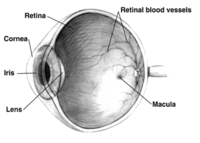
Photo from wikipedia
Background: The aim of this study was to test the feasibility and safety of subretinal transplantation of human induced pluripotent stem cell (hiPSC)-derived retinal pigment epithelium (RPE) cells into the… Click to show full abstract
Background: The aim of this study was to test the feasibility and safety of subretinal transplantation of human induced pluripotent stem cell (hiPSC)-derived retinal pigment epithelium (RPE) cells into the healthy margins and within areas of degenerative retina in a swine model of geographic atrophy (GA). Methods: Well-delimited selective outer retinal damage was induced by subretinal injection of NaIO3 into one eye in minipigs (n = 10). Thirty days later, a suspension of hiPSC-derived RPE cells expressing green fluorescent protein was injected into the subretinal space, into the healthy margins, and within areas of degenerative retina. In vivo follow-up was performed by multimodal imaging. Post-mortem retinas were analyzed by immunohistochemistry and histology. Results: In vitro differentiated hiPSC-RPE cells showed a typical epithelial morphology, expressed RPE-related genes, and had phagocytic ability. Engrafted hiPSC-RPE cells were detected in 60% of the eyes, forming mature epithelium in healthy retina extending towards the border of the atrophy. Histological analysis revealed RPE interaction with host photoreceptors in the healthy retina. Engrafted cells in the atrophic zone were found in a patchy distribution but failed to form an epithelial-like layer. Conclusions: These results might support the use of hiPSC-RPE cells to treat atrophic GA by providing a housekeeping function to aid the overwhelmed remnant RPE, which might improve its survival and therefore slow down the progression of GA.
Journal Title: International Journal of Molecular Sciences
Year Published: 2021
Link to full text (if available)
Share on Social Media: Sign Up to like & get
recommendations!